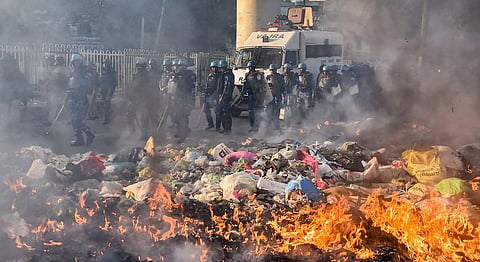
- HOMEGROWN WORLD
- #HGCREATORS
- #HGEXPLORE
- #HGVOICES
- #HGSHOP
- CAREERS
- ABOUT US
- CONTACT US

Clashes between supporters and opponents of the controversial Citizenship Amendment Act 2019 has rapidly escalated into a full-blown communal riot between Hindus and Muslims in working-class neighbourhoods (Maujpur and surrounding areas) on the fringes of the Delhi.
An official estimate of 38 people have been declared dead, and 200 people declared injured. These riots come in the wake of a three-day ultimatum issued by B.J.P. leader and former legislator, Kapil Mishra, to the Delhi Police to clear the roads being occupied by the protestors, failing which he said he would forcefully end the protests. The most spine-chilling incident of the riots include a mob vandalising and torching down the Badi Masjid at Ashok Nagar. After desecrating the interiors of the mosque, they climbed the minaret and planted a saffron flag, as well as the tricolour on top. This is a striking assault on the ethos of secularity that the Indian constitution embodies, as well as a possible precursor to more such incidents.
As reported by The Print, the residents of the houses that were set on fire by the same mob were told by the police to leave their homes for their own safety and provided shelter at the police station. Mohammad Khursheed, an Ashok Nagar resident whose house was set on fire, recounts, “When we were at the police station, we started getting calls from our neighbours telling us that our home has been destroyed. We came back to this.” It was also reported that prayer mats of the mosque were burnt and torn pages from the Quran were strewn outside the mosque. A mob sloganeering Jai Shri Ram and Hinduon ka Hindustan (India for Hindus) marched around the mosque on fire. Shops near the mosque were looted. According to the locals, the attackers were not the residents and had come to the locality from outside. Another mosque was vandalised in Gokulpuri.
The most telling aspect of these communal clashes has been its resounding echoes with the Gujarat riots of 2002, as well as the anti-Sikh riots of 1984. Nearly 3,000 people were killed in anti-Sikh riots in the capital in 1984 after the then prime minister Indira Gandhi was assassinated by her Sikh bodyguards. In 2002, more than 1,000 people, mostly Muslims, died after a train fire killed 60 Hindu pilgrims in Gujarat. The police were accused of complicity in both riots.
One must not, however, make the mistake of believing this to be a solitary incident of communal hatred which has suddenly cropped up out of the blue. It is rather an inevitable culmination of systematic attempts to fuel communal sentiments for a large stretch of time. One of the ways in which the government has been able to incite communal tension whilst routinely evading responsibility for the same is by having a strong grip over all state machinery. A Delhi High Court judge, Justice Muralidhar was transferred to another state court in a late-night order because of his criticism of the passive role of the police in the riots, as well as his intended investigation on politicians belonging to the ruling party.
Amidst such hatred, however, there appeared rays of hope in the ways in which people from both the Hindu and Muslim communities came together to help each other. For instance, people from both communities could be seen collecting burnt pages of the Quran scattered outside the vandalized mosque in Ashok Nagar, in a heart-warming gesture of solidarity and compassion. In one part of Delhi, a gurudwara has opened its doors to the Muslim community. In Seelampur, the Dalits blocked the roads against mobs to protect their Muslim neighbours.
If you enjoyed reading this article, we suggest you also read:
